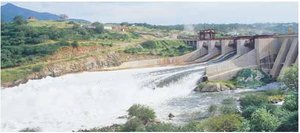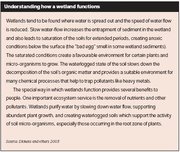Opportunities from freshwater in Africa
Contents
- 1 Introduction Africa’s freshwater system holds a vast array of opportunities. In 2005, only about 5 percent of the development potential of these resources – irrigation, industry, tourism (Opportunities from freshwater in Africa) and hydropower – was expected to be utilized. Freshwater resources can potentially be used to improve human well-being through meeting urgent water needs in the areas of health and food security.
- 2 Wetlands
- 3 Health and well-being
- 4 Irrigation
- 5 Hydropower
- 6 Tourism
- 7 Further Reading
Introduction Africa’s freshwater system holds a vast array of opportunities. In 2005, only about 5 percent of the development potential of these resources – irrigation, industry, tourism (Opportunities from freshwater in Africa) and hydropower – was expected to be utilized. Freshwater resources can potentially be used to improve human well-being through meeting urgent water needs in the areas of health and food security.
Wetlands
Freshwater is an integral part of the environment and its temporal and spatial availability is indispensable to the efficient functioning of wetlands and lakes, including coastal beneficiaries such as mangrove forests and other coastal wetlands.
The largest inland wetlands include: the Congo River swamps, the Sudd in the upper Nile, the Lake Victoria basin, the Chad basin, the Okavango Delta, the Bangweulu swamps, the Lake Tanganyika basin, the Lake Malawi/Nyasa/Niassa basin, and the floodplains and deltas of the Niger and Zambezi rivers.
These wetlands provide a number of environmental goods and services including flood control, erosion control, and toxicant removal and/or retention. The lakes are a habitat for major sources of nutritional supplies of fish, which are mostly treated as open access resources for subsistence and commercial use. Wetlands and freshwater bodies are associated with rare varieties of plant and animal species. In addition to this rich biodiversity they are also an important source of food. Further, they may serve as important transport waterways and are important areas for tourism, such as the St Lucia Wetlands on South Africa’s east coast which have been declared a World Heritage Site.
Health and well-being
In 2002, the United Nations Economic and Social Council (ECOSOC) recognized water as a human right. Clean and safe drinking water for domestic use is widely considered as one of the most urgent water needs. Only 51 percent of rural areas had access to water supply in 2002, compared with 86 percent in urban areas.
 Children playing in a stream on the outskirts of Brazzaville, Congo. (Source: M. Marzot/FAO)
Children playing in a stream on the outskirts of Brazzaville, Congo. (Source: M. Marzot/FAO) Access to safe water is a precondition for health and for success in the fight against poverty and hunger. It is crucial for meeting several of the Millennium Development Goals’ (MDGs) targets including:
- Target 1: Reduce by half the proportion of people living on less than a dollar a day;
- Target 2: Reduce by half the proportion of people who suffer from hunger;
- Target 5: Reduce by two-thirds, between 1990 and 2015, the under-five mortality rate; and
- Target 10: Halve, by 2015, the proportion of people without access to safe drinking water and basic sanitation.
Recreation and rest are also important aspects of human well-being. For many rural people, especially children, rivers provide one of the few opportunities for recreation.
Irrigation
Meeting irrigation water needs, for food security and economic development (Economic change in Africa), is another important area. Several basins are used for irrigated agriculture. These include the Limpopo basin which provides 82 percent of the potential irrigation area of approximately 0.3 million hectares (ha), and the Nile basin which provides over 50 percent of the potential 10 million ha. Egypt and Sudan utilize 70 percent of their respective shares of the basin land of 4.4 million ha and 2.8 million ha. Utilization of potential irrigation areas of other basins is less (e.g., Congo: only 0.4 percent; Zambezi: only 5 percent; and Niger: 33 percent). With its 30.3 million km2 of irrigation potential, Africa provides considerable opportunities for further expansion of irrigated agriculture.
In meeting urgent water needs, there is scope for alternative technologies, such as rainwater harvesting, wastewater recycling and desalination. Wastewater recycling is practiced in particular in Southern Africa. As early as 1994, Windhoek, Namibia, was recycling 13 percent of its wastewater for domestic consumption, while Harare, Zimbabwe, was recycling 10 percent. Gaborone, Botswana, plans to recycle 60 percent of its urban flow by the year 2020. Artificial groundwater recharge may be applied to enhance the sustainability and yield of aquifers. In Egypt, for example, at present 40 million m3 per year of drainage water is re-used for irrigation. An extra 30 million m3 per year in Egypt could be considered for re-use in the future. Another way of recycling is re-use of treated wastewater which could be increased from the present 5 million m3 per year to 25 million m3 per year by the year 2010.
Hydropower
Per capita electricity consumption in Africa is still low (515 kilowatt-hours [kWh]/capita) compared to the world’s average (2326 kWh/capita). At the household level, only 20 percent have access to electricity: However, in Northern Africa household access is significant, averaging 86 percent, with some countries including Algeria, Egypt, Libya and Tunisia reaching 95 percent. In contrast, the rest of Africa averages 15 percent, with Central Africa having the lowest rate at only 9 percent.
Although many of Africa’s rivers could be utilized for electricity generation, less than 5 percent of the economically feasible hydropower potential, of one million gigawatt-hours (GWh) per year, is being utilized. Hydropower contributes about 20 percent to overall electricity generation.
 Hydroelectric dam, Tanzania.
Hydroelectric dam, Tanzania.(Source: M. Edwards/Still Pictures)
The Congo River accounts for nearly 30 percent of Africa’s surface water reserves and has the largest hydropower potential in the world. It has vast untapped potential. It is estimated that it could generate 40,000 megawatts (MW), sufficient power supply for the whole of Africa and to have sufficient over to export. South Africa’s power generating company, ESKOM, plans to develop a hydropower dam at Inga on the Congo River. It will have a series of 52,750-MW turbine installations at the Inga Rapids, and its installed capacity would be more than twice that of the huge Three Gorges Dam in China. Its estimated cost is US$50,000 million. Small-scale generation also holds important opportunities with, perhaps, fewer of the environmental costs. Small power plants have the potential to meet the energy needs of rural and off-grid communities. These plants are classified into three types: small (1 – 10 MW), mini (100 KW – 1 MW) and micro (< 100 KW). Hydropower has the potential to supply low-cost electricity in several countries. However, droughts are increasing in severity and frequency, posing a major threat to a reliance on hydropower.
Hydropower development faces several barriers. These include lack of investment, low technical capacity, and a weak regulatory and policy environment. Several factors contribute to the high cost of hydropower plants. These include the employment of foreign experts in planning and design; lack of local investment capital; long lead times; lack of local production capacity; and comparatively low demand or poor economies of scale. The environmental and social costs associated with large dams are making this a less attractive option for harnessing hydropower potential. The World Commission on Dams (WCD), for example, noted that:
The global debate about large dams is at once overwhelmingly complex and fundamentally simple. It is complex because the issues are not confined to the design, construction and operation of dams themselves but embrace the range of social issues, environmental and political choices on which the human aspiration to development and improved wellbeing depend. Dams fundamentally alter rivers and the use of a natural resource, frequently entailing a relocation of benefits from local riparian users to new groups of beneficiaries at a regional or national level. At the heart of the dams debate are issues of equity, governance, justice and power – issues that underlie the many intractable problems faced by humanity.
With careful planning, however, hydropower potential can be developed and utilized while minimizing the negative environmental and social impacts.
The feasibility of large dams and the implications for environment and social systems are contested.
Tourism
Water-based tourism is important in several localities and in such places it is often an integral part of livelihoods systems, providing a range of income and business opportunities. Zimbabwe’s Lake Kariba and Malawi’s Lake Malawi are examples of this, and support photographic and sports-based tourism. Lake Malawi hosts a rich diversity of tropical freshwater fish – it has more species of fish than any other lake in the world.
Further Reading
- AQUASTAT, Food and Agricultural Organization.
- Dickens, C., Kotze, D., Mashigo, S., MacKay, H and Graham, M, 2003. Guidelines for integrating the protection, conservation and management of wetlands into catchment management planning. Water Research Commission Report TT220/03. Water Research Commission, Pretoria
- ECA, 2000. Transboundary River/Lake Basin Water Development in Africa: Prospects, Problems, and Achievements. United Nations Economic Commission for Africa, Addis Ababa.
- ECA, AU and AfDB, 2000. The Africa Water Vision for 2025: Equitable and Sustainable Use of Water for Socioeconomic Development. Economic Commission for Africa, African Union and African Development Bank. Addis Ababa.
- Hathaway, T., 2005. Grand Inga, Grand Illusions? International Rivers Network, Berkeley.
- Lokolo, C. 2004. Enlightening a Continent in the Dark – Prospects for Hydropower Development in Africa. Proceedings of the United Nations Symposium on Hydropower and Sustainable Development. Beijing, China, 27-29 October 2004.
- Mohammed, S. and Francis, J., 2002. The Regional Annex to the Recommended Framework for Decision-Making: Eastern Africa Region.
- Murray, E.C. 2004. Artificial groundwater recharge – Wise water management for towns and cities. WRC Report No. TT 219/03. Water Research Commission, Pretoria.
- NEPAD, 2003. Action Plan for the Environment Initiative. New Partnership for Africa’s Development, Midrand.
- Ogunlade, D. and Youba, S., 2002. Energy and Sustainable Development: Key Issues for Africa. Bulletin Africa, 15:4-14.
- UNEP, 2006. Africa Environment Outlook 2
- UNEP, 2006. Africa Environment Outlook 2, Annexes
- WCD, 2000. Dams and Development: A New Framework for Decision-making, The Report of the World Commission on Dams. Earthscan Publications, London.
- WHO and UNICEF, 2004. Meeting the MDG Drinking Water and Sanitation Target: a Mid-term Assessment of Progress. World Health Organization and United Nations Children’s Fund.
|
|
| Disclaimer: This article is taken wholly from, or contains information that was originally published by, the United Nations Environment Programme. Topic editors and authors for the Encyclopedia of Earth may have edited its content or added new information. The use of information from the United Nations Environment Programme should not be construed as support for or endorsement by that organization for any new information added by EoE personnel, or for any editing of the original content. |
